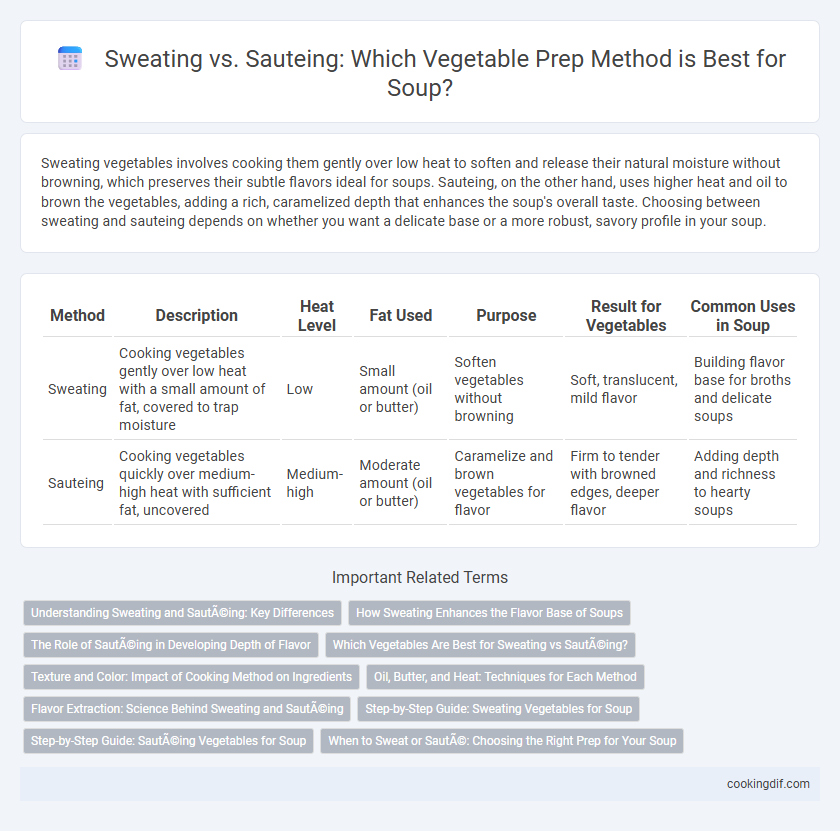Sweating vegetables involves cooking them gently over low heat to soften and release their natural moisture without browning, which preserves their subtle flavors ideal for soups. Sauteing, on the other hand, uses higher heat and oil to brown the vegetables, adding a rich, caramelized depth that enhances the soup's overall taste. Choosing between sweating and sauteing depends on whether you want a delicate base or a more robust, savory profile in your soup.
Table of Comparison
| Method | Description | Heat Level | Fat Used | Purpose | Result for Vegetables | Common Uses in Soup |
|---|---|---|---|---|---|---|
| Sweating | Cooking vegetables gently over low heat with a small amount of fat, covered to trap moisture | Low | Small amount (oil or butter) | Soften vegetables without browning | Soft, translucent, mild flavor | Building flavor base for broths and delicate soups |
| Sauteing | Cooking vegetables quickly over medium-high heat with sufficient fat, uncovered | Medium-high | Moderate amount (oil or butter) | Caramelize and brown vegetables for flavor | Firm to tender with browned edges, deeper flavor | Adding depth and richness to hearty soups |
Understanding Sweating and Sautéing: Key Differences
Sweating vegetables involves cooking them gently over low heat with a small amount of fat, allowing them to soften and release moisture without browning, which helps preserve their delicate flavors and textures ideal for soups. Sauteing uses higher heat and more fat to cook vegetables quickly, producing a browned, caramelized exterior that adds depth and richness to the soup base. Understanding these techniques enables precise control over vegetable flavor development and texture in soup preparation.
How Sweating Enhances the Flavor Base of Soups
Sweating vegetables involves cooking them gently at a low temperature to release their natural sugars and moisture without browning, creating a sweet and subtle flavor base for soups. This method softens ingredients like onions, carrots, and celery, allowing their aromas to meld and infuse the broth with depth and complexity. Sweating preserves delicate flavors, ensuring the soup's final taste is rich, balanced, and aromatic.
The Role of Sautéing in Developing Depth of Flavor
Sauteing vegetables in soup preparation enhances depth of flavor by promoting caramelization and Maillard reactions, which release complex, savory notes absent in sweating. Unlike sweating, which gently softens vegetables while retaining moisture, sauteing uses higher heat to brown the ingredients, intensifying aromatic compounds and enriching the soup's overall taste profile. This technique is essential for creating a robust and layered flavor foundation in hearty soups.
Which Vegetables Are Best for Sweating vs Sautéing?
Leafy greens like spinach and kale are best suited for sweating, as the low heat gently softens them without browning, preserving their delicate texture and nutrients. Firmer vegetables such as onions, carrots, and bell peppers benefit from sauteing, where higher heat develops caramelization and deepens flavor through Maillard reactions. Understanding these differences ensures optimal texture and taste in soups by matching vegetables to the appropriate cooking technique.
Texture and Color: Impact of Cooking Method on Ingredients
Sweating vegetables involves cooking them gently in a small amount of fat over low heat, which softens the texture and preserves their natural color without browning. Sauteing uses higher heat and agitation, producing a firmer texture and caramelized color through browning reactions. Choosing between sweating and sauteing influences the final soup's ingredient texture and vibrant appearance, affecting flavor development and visual appeal.
Oil, Butter, and Heat: Techniques for Each Method
Sweating vegetables involves cooking them gently over low heat with a small amount of oil or butter, allowing moisture to release without browning, which enhances natural flavors and softens textures ideal for soups. Sauteing requires higher heat and more oil or butter, creating a browning effect known as the Maillard reaction that adds depth and richness to vegetable flavors. Choosing the right combination of fat and heat level ensures optimal flavor development and texture control during soup preparation.
Flavor Extraction: Science Behind Sweating and Sautéing
Sweating vegetables gently in low heat releases their natural moisture, preserving subtle flavors and creating a tender base for soups. Sauteing at higher temperatures promotes caramelization through the Maillard reaction, intensifying savory notes and adding depth to the broth. Understanding the balance between sweating's moisture retention and sauteing's flavor development enhances soup complexity and richness.
Step-by-Step Guide: Sweating Vegetables for Soup
Sweating vegetables for soup involves cooking them gently over low heat with a small amount of oil or butter until they become soft and translucent, typically taking 5 to 10 minutes. This process releases the vegetables' natural sugars and enhances their flavor without browning, essential for a clear, delicate soup base. Covering the pan helps trap moisture, ensuring even cooking and preserving the vegetables' sweetness and texture.
Step-by-Step Guide: Sautéing Vegetables for Soup
Sauteing vegetables for soup involves heating a small amount of oil or butter in a pan over medium-high heat, then adding evenly chopped vegetables to cook until they develop a golden-brown color and tender texture, usually within 5 to 7 minutes. This method enhances flavor through caramelization and concentrates the vegetables' natural sugars, creating a richer base for soups. Maintaining consistent heat and stirring occasionally prevents burning and ensures even cooking, essential for achieving a depth of taste in the final dish.
When to Sweat or Sauté: Choosing the Right Prep for Your Soup
Sweating vegetables involves cooking them gently over low heat in a small amount of fat, allowing them to soften and release moisture without browning, ideal for creating a subtle, mellow base in soups like minestrone or chicken noodle. Sauteing uses higher heat to cook vegetables quickly, developing caramelization and deeper flavors, perfect for hearty soups such as French onion or roasted tomato bisque. Selecting between sweating and sauteing depends on the desired flavor profile and texture, with sweating preserving delicate aromas and sauteing enhancing richness through Maillard reactions.
Sweating vs Sautéing for vegetable prep Infographic

 cookingdif.com
cookingdif.com